The cyber-physical manufacturing journey
Society is undergoing a large-scale transformation as the trend for smarter technology is continuing. In these modern times, manufacturing businesses need to become smarter, but the question is, what should they do? Dr. Koji Yasui, Mitsubishi Electric’s Senior Chief Engineer at the Factory Automation Systems Group, Industrial Automation Marketing Division shares his insights, based on his experience leading the discussion and writing about the smart society, as well as his participation in a number of government projects in Japan.
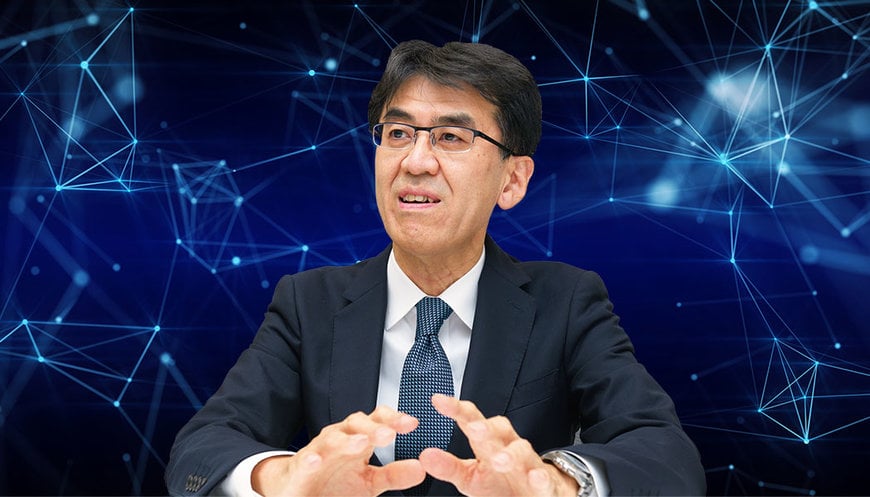
Industry is facing the biggest changes it has seen in centuries.
We've been saying for a long time that the next industrial revolution will be triggered by advances in digital technology. The latest industrial revolution is directed at the smartification of society, whereby all aspects of society will operate in an autonomous and smartly coordinated fashion. For example, smart grids to advance the supply of electricity were promoted by the United States around 2009. This was followed by a boom in 3D printers in 2014, and around 2015, Germany's Industry 4.0 prompted a lot of discussion in Japanese domestic industrial circles.
While the entities involved and the content differs, all these initiatives have the same goal, that is to drive a smart society through various means. Experts predicted that the new industrial revolution would kick off in full swing around 2020. And it is true to say we have seen advances in semiconductors and emerging technologies such as the Internet of Things (IoT), artificial intelligence (AI), 5G communications and blockchains. We have also been starting to see the development of quantum computing and communications. So, 2020 seemed to be a historic year with the industrial revolution really hitting its stride.
Furthermore, through the pandemic digitalization gained momentum, and even in Japan, which lagged far behind, working from home and remote meetings became common practice. It was potentially one of the greatest transformations since the first British industrial revolution 200 years before.
As mentioned, during the pandemic investments in the digitalization of the manufacturing sector soared, particularly around 2021. At its start, many manufacturing sites had to cease operations, while those that could continue production did so owing to digital technologies that allowed remote monitoring and control. With the usefulness of digitalization being more evident than ever to the manufacturing industry, investment got into full swing. Keywords in use before the pandemic, such as digital transformation (DX), became more popular in Japan as many manufacturers started to introduce the Industrial IoT (IIoT) and made improvements in their digital infrastructures.
The smart manufacturing trend spread to electric vehicle (EV) production, where there has been significant investment in the digitalization of battery plants. Furthermore, the semiconductor shortages experienced during the pandemic also led to increased digital investments in that industry, as semiconductors are one of the key components in all electronic products, from batteries to smartphones. Those investments in digitalization are starting to bring results, moreover, key events in 2022 triggered concerns about energy security, especially in Europe, and so digitalization investments also began to expand into the energy sector as well.
Given the background, it is time for manufacturers to start their own digitalization and ride the wave of the latest industrial revolution. Investments in digital technologies are rapidly progressing, particularly in larger corporations, and are expected to accelerate further in the future.
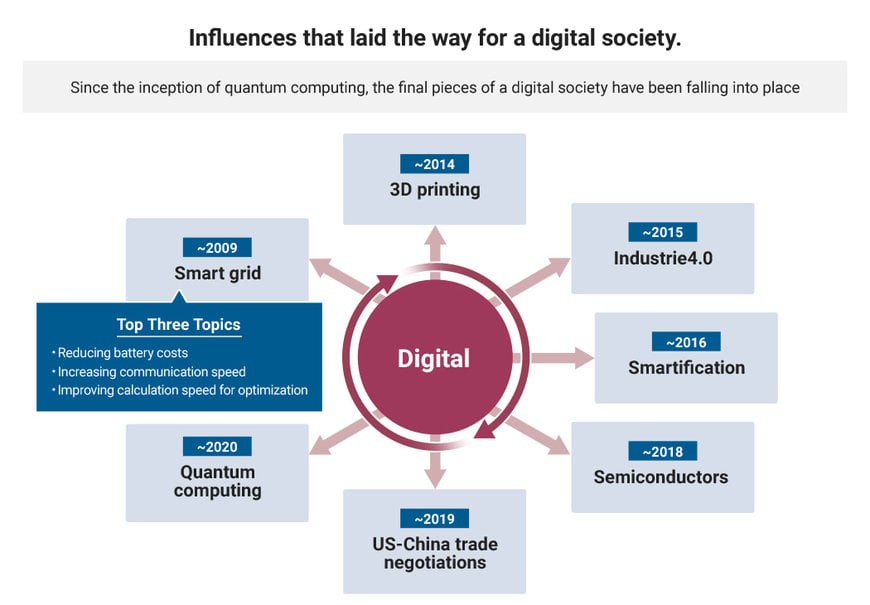
Influences that laid the way for a digital society.
Amidst society’s call for a rapid application of smarter technology, how is the manufacturing industry addressing this issue?
In Japan, we call the smart society at the heart of the new industrial revolution, Society 5.0. Such smart societies are clearly more resilient to uncertainties, and will be effective in finding solutions to today’s challenges such as energy security. For example, if every household was fitted with solar panels and a battery system, it would be possible for homes to have electricity without relying on the grid.
Thinking about Japan's manufacturing sites, which were already relatively well equipped for smart manufacturing including using remote monitoring and control functionalities, so from an operational point of view they were able to remain largely unaffected during the pandemic. The benefits of using cutting-edge digital technologies not only provided immediate results but also created opportunities. Recently, Japan has also attracted semiconductor manufacturers to the country, creating an environment more conducive to meeting digitalization challenges.
Moreover, I believe that the global push towards a sustainable society presents an opportunity for manufacturers. Let me explain. The digitalization of the EV and energy sectors is a hot topic now, being so closely related to global decarbonization and net zero strategies. From my perspective, Japanese companies across the value chain of applicable technologies have significant opportunities here. For example semiconductor factories, which produce the components used as building blocks for the latest digital technologies, and data centers which process large volumes of digital data, are both intensive energy users. In this regard, energy-saving technologies are exactly what Japanese companies excel at, and the world as a whole is actively looking for these capabilities right now.
The key to solving the challenge
In terms of making manufacturing smarter, I believe the goal should be to create cyber-physical systems (CPS) that allow companies to optimize their operations and activities in the actual physical space, based on insights from the virtual model. As a first step, it is necessary to establish digital twins (digitized alter egos) of people and machines that exist in the physical world, recreated in cyberspace. Incidentally, cyberspace is not exclusively in the ‘cloud’, but can also be generated using on-premises servers installed within the company’s facilities or it can even extend to 'Edge' devices such as PCs and smartphones.
The origins of the digital twin concept can be found in the development of smart grids back in 2009. This early work has helped to address key challenges to the realization of today’s digitalization. For example, battery storage costs needed to be reduced by a factor of ten whilst the speed of data exchange and computer processing had to increase by a factor of ten to support the data processing needs.
The prices of battery storage are now one-tenth of what they were because of increased investments in EVs. With the introduction of 5G, and work already underway on next generation 6G, communication speeds are expected to exceed today’s requirements. Moreover, progress is being made on practical applications of quantum computing, a technology that can be extremely powerful in the optimization of key activities when compared to conventional computing. Additionally, EV manufacturing sites around the world are already leveraging CPS, including in Japan, where large companies are taking the lead in accelerating such efforts.
As costs are reduced, newer technologies become easier to develop and implement. So, I recommend that manufacturers make use of the most promising current technologies and quickly move on to make their company smarter.
Manufacturing capabilities will remain the source of competitiveness in a digital society. Therefore, identify your strengths.
Small and mid-sized production sites can find connecting their equipment to cyberspace a big challenge. When a company decides to make their factory smarter, what approach should they take and how should they proceed in a practical sense?
Digital twins used to recreate a manufacturing process in cyberspace are relatively easy to build, especially when it comes to replicating component assembly lines, which is what most larger companies are involved with. However, there can be challenges when it comes to specific machining operations, for example such as grinding and polishing, where many small and mid-sized companies excel, unfortunately it is often the case that these companies have limited budget available for investments.
Addressing this issue has been a global challenge. The Japanese government, for example, has taken a view on scientific and technical innovations from a national perspective, establishing the Strategic Innovation Promotion (SIP) Program. This has strengthened measures for the large-scale adoption of cutting-edge technologies. I was fortunate enough to participate in the program for ‘Technology to Realize Society 5.0 Using Light and Quantum’, and was also actively involved in the social implementation of academic research solutions. Through our work we identified that we are becoming academically and technically capable of converting the machining expertise of skilled workers into digital data. As a result, this kind of technology is now entering an implementation phase within our wider society.
From a manufacturer’s perspective, the reality is digital twins do require some level of investment, so I recommend first looking at small on-site digital improvements that can form the foundation for further smart applications. To achieve this, digitalization budgets should focus on enabling technologies that can drive growth and flexibility to meet changing business conditions.
The strength of digital twins is that we can trial different ideas in cyberspace. This helps us to identify the methods that generate the greatest improvements for the physical processes. Despite digital twins being in cyberspace, they are still based on the physical reality that represents a set of manufacturing capabilities. These capabilities are at the core of a factory's competitiveness, and so the priority should be to strengthen them. Digital twins are an excellent way of improving performance and quality, and subsequently boosting profits.
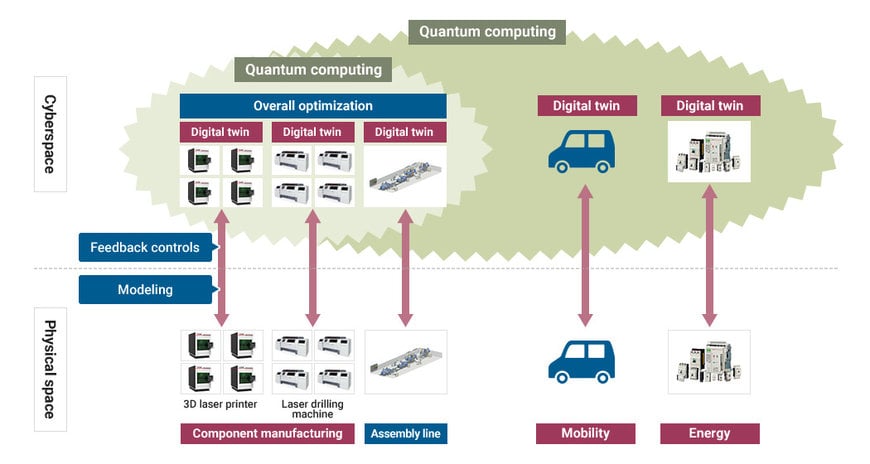
A digital twin system developed for the manufacturing industry can expand into mobility and energy sectors.
When small or mid-sized companies start to utilize digital twins, this enables the entire supply chain to be optimized with the addition of this missing part. The digital twins developed for the manufacturing industry can also be deployed in the mobility and energy sectors in the form of EV production, as well as in the food and beverage, pharmaceutical and healthcare sectors, which all face global issues and have great potential for development.
The changes we are seeing are the most significant in several hundred years, so it is important not to panic or over-react, but to take time and consider carefully. Every company has unique facets, such as expertise, market knowledge or domain know-how, these core values should be built on. Just as Japan's manufacturing industry is technologically strong in areas such as energy conservation, other countries and companies should identify their unique strengths as well. I believe one important step of the journey is to utilize new tools such as digital twins, IoT, AI and 5G to support each company’s smarter development of their inherent strengths.
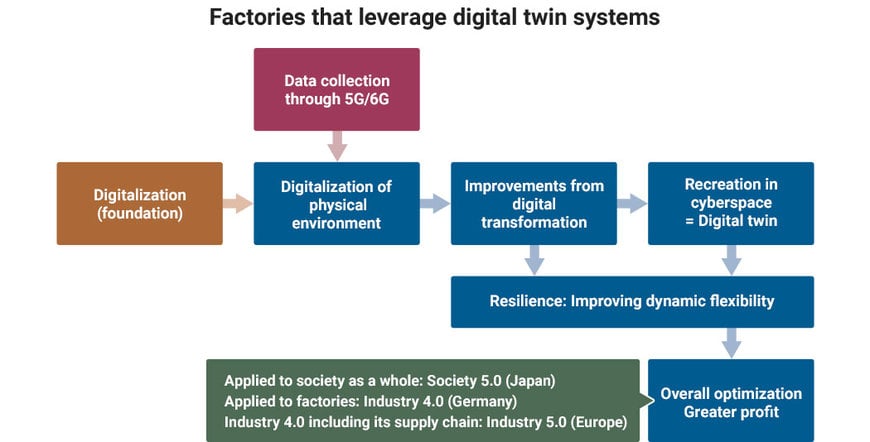
Factories that leverage digital twin systems
First, companies should review their capabilities and polish their strengths. It is important to then actively communicate these to the rest of the world and develop them further. Becoming smarter can be a tool for communicating a company’s strengths to the outside world and connecting with partners who can best leverage the technology.
Taking those first steps towards smartification.
Mitsubishi Electric identified the movement toward smart technology early on. We launched the 'e-F@ctory' digital manufacturing concept more than a decade before Germany's Industry 4.0 framework. Furthermore, we have been closely following the latest developments in industry, government, and academia, from smart grids and 3D printers to the fourth industrial revolution boom and, more recently, quantum computing and communications. As mentioned earlier, Mitsubishi Electric is also involved in national projects relating to the implementation of science and technology within our society, and is continuously working with customers to help them meet their digitalization challenges.
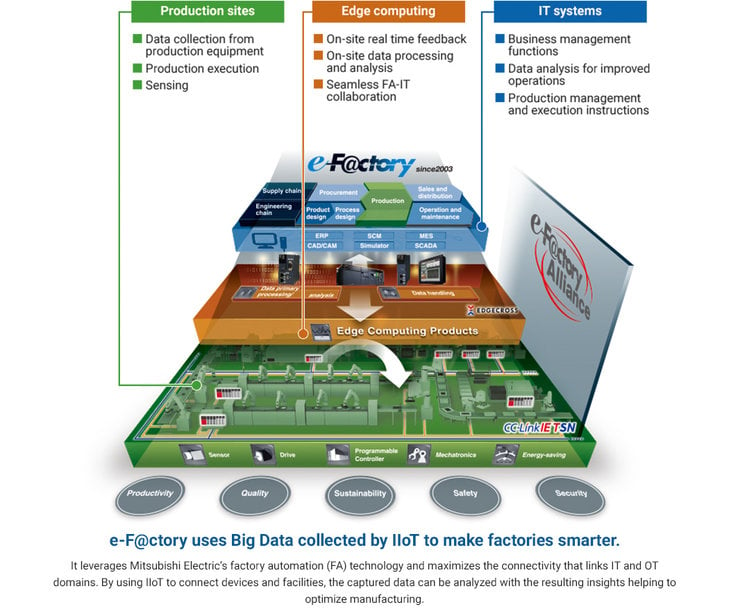
e-F@ctory uses Big Data collected by IIoT to make factories smarter.
It leverages Mitsubishi Electric’s factory automation (FA) technology and maximizes the connectivity that links IT and OT domains. By using IIoT to connect devices and facilities, the captured data can be analyzed with the resulting insights helping to optimize manufacturing.
When Mitsubishi Electric launched the e-F@ctory concept 20 years ago, many of the technologies had not been fully realized and there were still some challenges, especially in terms of cost. However, our company has consistently and confidently presented a future vision of a world based on the use of digital technologies, and now we can see that major trend is now becoming a reality. Mitsubishi Electric has provided a number of products - each has its key strength and contributes to helping solve real-world challenges. Additionally, through our participation in programs like SIP, we have strengthened our cooperation with universities and research institutions, and this is enabling us to provide more advanced solutions to our customers.
We are all coping with a rapidly changing and growing market, so it is essential to gather information and market trends. However, collecting that kind of information alone can be difficult. We therefore hope that companies will be able to utilize the insights we have gathered.
Moreover, you may find issues that need to be urgently addressed. Many of the technologies that can solve these problems are already available but there is a need to commercialize and provide solutions even quicker and more efficiently than before. We hope that industry players will consider using Mitsubishi Electric's manufacturing equipment and other solutions to assist them in their efforts.
In order to respond to growing market demands it is essential to utilize an “ecosystem” that delivers the necessary technologies needed by manufacturing industries. Such an ecosystem should be independent yet be founded on mutual coexistence and co-prosperity, while ensuring a win-win for all. In particular, the creation of a sustainable and collaborative society will be an important topic in the future, and we will need to find ways to include as many people as possible in this ecosystem. Through my own participation in the SIP Program, I have become involved in the development of several ecosystem bases, including one at Kyushu University that targets the semiconductor industry. I hope that our customers will also consider leveraging such ecosystems like these.
As we emerge after the pandemic, the adoption of digitalization is accelerating in response to social changes. I may be repeating myself, but we at Mitsubishi Electric have long been preparing for this future as we strive to help our customers to maintain and expand their manufacturing successes. I recommend companies to take this chance to implement the latest solutions and accelerate their own progress towards digitalization and smartification.
Profile: Dr. Koji Yasui
Born in 1959. He graduated from the Department of Physical Engineering, Faculty of Engineering, University of Tokyo. He holds a PhD in Engineering. Since joining Mitsubishi Electric in 1982, he has worked in research and production divisions as deputy director and general manager. Currently, he is the Senior Chief Engineer of Factory Automation Systems Group. He participated in the development of industrial laser cutting machines as a researcher, and managed teams responsible for the development of electrical discharge machines, NC controllers and electron beam machines. He now takes these products to market, both domestically and internationally, as a member of the marketing division. Yasui also participates in collaborative activities involving industry, government, and academia to highlight technologies that meet customer needs. He has been active as a sub-program director and sat on several committees as part of the Japanese government’s Strategic Innovation Promotion Program (SIP Program).
Author of “Keys to Surviving a Sustainable Society”, 2022. Available on Amazon in Japan.
Originally (initially) released in Japanese

